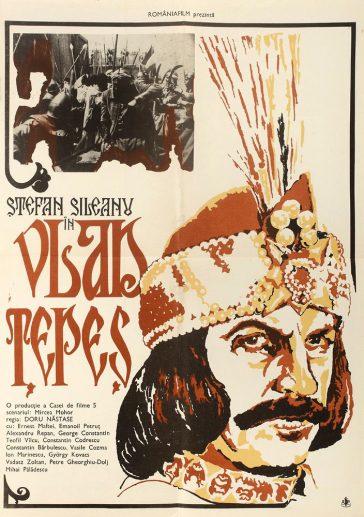 Vlad the Impaler, a.k.a. Vlad Tepes (1428/31–1476/77), was the historical personage who inspired Bram Stoker’s DRACULA, and the Romanian epic VLAD TEPES (1979) remains the only worthwhile Tepes film biopic. It exists in numerous different cuts—the full version runs 145 minutes, although an abbreviated 104 minute cut is more common—and deserves to be seen in any version.
Vlad the Impaler, a.k.a. Vlad Tepes (1428/31–1476/77), was the historical personage who inspired Bram Stoker’s DRACULA, and the Romanian epic VLAD TEPES (1979) remains the only worthwhile Tepes film biopic. It exists in numerous different cuts—the full version runs 145 minutes, although an abbreviated 104 minute cut is more common—and deserves to be seen in any version.
The year is 1456, with “Draculea” (so nicknamed because his father was named Vlad Dracul) forcibly seizing the throne of Romania’s Wallachia region. The film dramatizes the following six years, during which time Vlad strengthens Wallachia’s military appreciably and proclaims that any wrongdoing in the kingdom will be dealt with via decapitation. When this fails to curb the bad behavior Vlad takes more drastic steps, burning down a tavern filled with drunken louts and instituting an especially ruthless kingdom—wide deterrence: impalement. Before long Wallachia is riddled with up-thrust spears bearing impaled corpses.
Vlad is faced with several factions opposed to his rule. A malicious gossip campaign is carried out that proclaims Vlad an evil spirit and vastly inflates his outrages (claiming “If he would meet the Savior himself, he would crucify him a second time”). Vlad succeeds in putting down this insurgency, but is faced with the Ottoman sultan, who invades Wallachia seeking to usurp Vlad’s rule. Vlad, however, remains vigilant, poisoning the wells in the area and, dressed as a Turk, sneaking into the enemy’s base camp to kill the sultan. He succeeds only in pissing off his intended victim, who responds by kidnapping the women and children of Wallachia and threatening to behead them in mass (in which is featured the only notable female presence in the entire film).
Even worse, Vlad is imprisoned after seeking military assistance from the king of Hungary. It’s at this point that the film concludes, but, as we’re informed over the end credits, Vlad’s story didn’t end there.
A David Lean movie this isn’t, but director Doru Nastase has created a striking epic canvas, containing battle scenes packed with what look like thousands of costumed extras (for more evidence of Nastase’s talent for panoramic carnage see his masterful 1975 wartime drama NO TRESPASSING/PE AICI NU SE TRECE). There’s also some cinematic innovation to be found in the kinetic editing, but narratively the film is very old-fashioned in its approach, presenting this dark saga in Shakespearean terms, i.e. as a drama headlined by kings, with common folk relegated to the background.
The film’s primary interest is its presentation of the title character. Vlad Tepes is a national hero in his native Romania and a horror icon in much of the rest of the world, a dichotomy of which this film is fully aware. Here Vlad is presented much like the title character in DIRTY HARRY: a tough but virtuous man whose biggest problem is bad press.
That attitude, accurate or not, is bolstered by a towering lead performance by the late Stefan Sileanu (1939-2020). He cuts an imposing figure, anchoring the film quite adroitly while also conveying a sense of humanity in what is unquestionably one of the decade’s greatest performances.
Vital Statistics
VLAD TEPES
Romania Film
Director: Doru Nastase
Producer: Dumitru Fernoaga
Screenplay: Mircea Mohor
Cinematography: Aurel Kostrakiewicz
Editing: Adina Georgescu-Oborcea
Cast: Stefan Sileanu, Ernest Maftei, Emanoil Petrut, Emanoil Petrut, Teofil Vâlcu, Alexandru Repari, Constantin Codrescu, George Constantin, Constantin Barbulescu, Ion Marinescu, Silviu Stanculescu, Vasile Cosma, Petre Simonescu, György Kovács, Mihai Paladescu, Petre Gheorghiu Dolj
